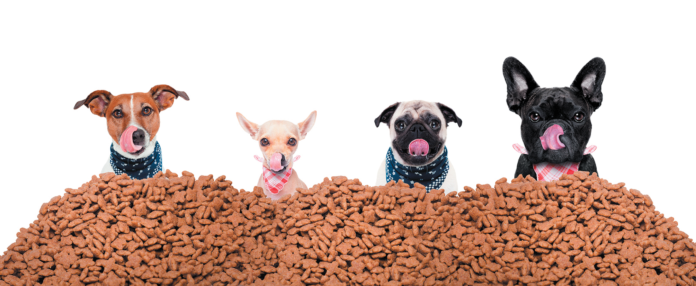On the face of it, there are a number of reasons to allow your dog unlimited access to food rather than doling it out in measured portions. One is that she will never go hungry. Like us, dogs are hungrier some days than others, and free feeding will allow her to eat more when she would otherwise feel famished between meals.
In the same vein, free feeding can work well for those days that a dog engages in more vigorous physical activity than others and therefore requires more calories to feel sated. A pregnant or lactating dog might also need to have free access to food to insure her calorie needs are met.
Finally, if a dog is prone to food guarding and becomes aggressive about food with her canine (or feline) housemates, free feeding can potentially help attenuate the tendency. Because free feeding takes away anxiety about food, it might also take away a dog’s need to guard it.
For all that, however, we are not big fans of free feeding most dogs. As many of our readers know, dogs can be bottomless pits. Some are genetically programmed to eat as much as their bodies can handle and will therefore more or less eat as much food as you put in front of them. With the epidemic of canine obesity, we don’t need to be encouraging overconsumption.
Free feeding becomes especially complicated in households with more than one pet. It increases the chances that one dog will eat the other dog’s food, setting up even more potential for obesity and also creating problems if the two animals need to be on different diets for medical reasons. Additionally, it can set up unhappy power plays if one dog is pushier than the other about taking advantage of available resources.
Another downside: Free feeding can mean that dog food might be left in the bowl for many hours on end — not the greatest for hygiene when you consider that dust or even insects can make their way into the chow. And it makes it harder to see if your pet lost her appetite — often a sign of illness.
The Clinical Nutrition Service at the Tufts veterinary school suggests that people not even consider free feeding unless all of the pets in the household are already at ideal body condition (not overweight) and can maintain that status even if they are allowed to eat as much food as they want. And of course, food left out all day has to be okay for all the animals that might partake of it. If one of the dogs has heart disease and needs to be on a low-sodium diet, for instance, all the animals will have to adjust to low-sodium food.
Even though a dog may work up a good hunger between meals, she might enjoy the structure meals give to her day. A lot of dogs are bored much of the time. Mealtimes provide punctuation marks — a kind of environmental enrichment — during the long hours of lying around.
They also remind her that you are taking care of her and are in charge of her wellbeing. It’s a way of strengthening your bond with your pet.






As a trainer and fitness specialist for dogs, I don’t agree very much with this article.
I’ve actually found many dogs BECOME resource guarders when they are free fed. They also tend to be overweight more often than dogs who are fed a measured amount at scheduled feedings.
The more food is exposed to air, the more rancid it becomes. There is also evidence that dogs who are fasted through the night for 14-16 hours have lower blood sugar levels.
My Scottie’s nickname is “Mr. Piggy”. If I free fed him he’d be so overweight he would have a shorter life. So he gets his level one-third cup of food twice a day. He’s my seizure alert service dog and he is doing fine at 11 yrs old. His health is very important!